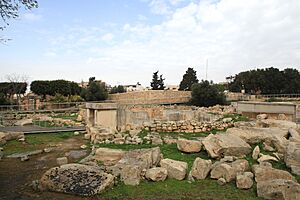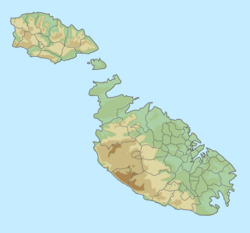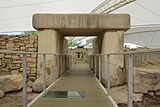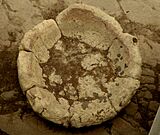Tarxien Temples facts for kids

Entrance to the Tarxien Temples
|
|
| Location | Tarxien, Malta |
|---|---|
| Coordinates | 35°52′9″N 14°30′43″E / 35.86917°N 14.51194°E |
| Type | Temple |
| History | |
| Material | Limestone |
| Founded | c.3250 BC–c.2800 BC |
| Periods | Tarxien phase |
| Site notes | |
| Excavation dates | 1915, 1963 |
| Archaeologists | Themistocles Zammit |
| Condition | Well-preserved ruins |
| Ownership | Government of Malta |
| Management | Heritage Malta |
| Public access | Yes |
| UNESCO World Heritage Site | |
| Part of | Megalithic Temples of Malta |
| Criteria | Cultural: (iv) |
| Inscription | 1980 (4th Session) |
| Extensions | 1992, 2015 |
| Area | 0.807 ha (86,900 sq ft) |
| Buffer zone | 11 ha (0.042 sq mi) |
The Tarxien Temples are an amazing ancient site in Tarxien, Malta. This archaeological complex is located in the Port area of the island. These temples are very old, dating back to about 3150 BC. They are part of a group of huge stone temples on Malta. In 1992, the Tarxien Temples became a UNESCO World Heritage Site, recognized for their importance to human history.
Contents
Exploring the Tarxien Temples
The Tarxien Temples are made up of three separate temple buildings that are connected. The main entrance you see today was rebuilt in 1956. At that time, many of the beautifully decorated stone slabs found here were moved. They are now kept safe indoors at the Museum of Archaeology in Valletta. This helps protect them from weather and time.
The first temple was built around 3100 BC. It is known for having the most detailed decorations of all the temples in Malta. The middle temple was built about 3000 BC. It is special because it has three pairs of apses (rounded rooms), which is different from most other Maltese temples that usually have two. The east temple also dates to around 3100 BC. You can also see the remains of an even older and smaller temple further east, built around 3250 BC.
One of the most interesting things about these temples is the amazing stonework. You can see carvings of farm animals, altars, and screens with spiral patterns. These designs show how skilled the ancient builders were. There's even a hidden room inside the wall between the South and Central temples. It has carvings of a bull and a sow (a female pig).
What Were the Temples Used For?
When archaeologists dug up the site, they found clues that the temples were used for important ceremonies. These ceremonies likely included animal sacrifice, where animals were offered. A cool discovery at Tarxien was large stone rollers left outside the South temple. These rollers were probably used to move the giant stone blocks (megaliths) into place.
Later, the site was used differently. Evidence of cremation (burning bodies) was found in the center of the South temple. This shows that during the Bronze Age, the area became a cemetery where people were cremated.
Discovery and History of the Temples

The huge stone blocks of the temples were first found by local farmers in 1914. They were ploughing a field when their tools kept hitting something hard. Just a year before, the Ħal Saflieni Hypogeum (an amazing underground temple) had been accidentally discovered nearby. Because of this, the owner of the land where the temples were buried thought these large stones might also be important.
He contacted Themistocles Zammit, who was the director of the National Museum. Zammit started digging right away during his first visit. He quickly found the center of the temple complex. Soon, he was standing inside a rounded room (apse) made of giant carved stones. For three years, Zammit worked with local farmers and townspeople. They carried out a huge digging project, bigger than anything seen in Malta before.
By 1920, Zammit had found and restored five connected temples. They contained many amazing artifacts. These included the famous "fat lady" statue, which might represent a Mother Goddess or a symbol of fertility. The Malta Archaeological Museum says this statue is genderless and could be a man or a woman. Many unique prehistoric carvings were also found, including pictures of ships.
In 1923, Zammit gave a small collection of items from the site to the British Museum. The temples were officially listed as important ancient sites in 1925. More digging happened after World War II, led by J.G. Baldacchino.
To protect the temples from the weather, large tent-like shelters were built over them in 2015. These are similar to the shelters at other famous Maltese temples like Ħaġar Qim and Mnajdra. The shelters were finished in December 2015.
Why the Tarxien Temples Are Important
The discovery of the Tarxien Temples was a huge deal for Malta. It strongly proved that a thriving ancient culture once lived on the island. This helped build Malta's national identity. The excitement about these finds also made people care more about protecting Malta's historical treasures.
For the first time, there was a public demand to manage these sites, create laws, and take other steps to protect and preserve ancient monuments. Also, Themistocles Zammit's careful way of digging at the site changed archaeology. His methods led to a new, more scientific approach to studying ancient places.
Gallery
See also
- List of megalithic sites








